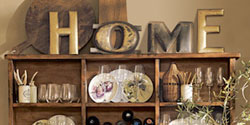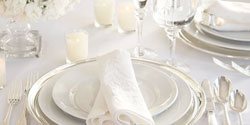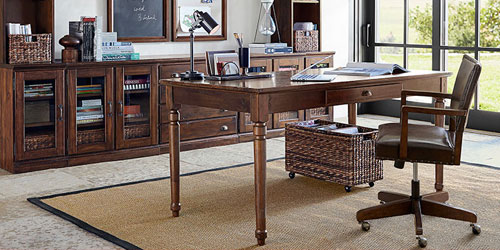6 Dining Room Table Setting Secrets
Your dining room table setting plays an important part in creating the atmosphere of a gathering. It adds color and personality to the tabletop, reflects how formal the event is, and can help keep conversation flowing throughout the evening. Putting some extra thought and effort into your table setting ensures that your guests are comfortable at the table and encourages an intimate dining experience. You can also use color and accents to create a striking tabletop that other diners will remember for years to come.

1
Color Sets the Tone
The colors you choose set the mood for your gathering so consider the serveware you plan on using for the event Layer classic colors like whites and neutral colors for more formal affairs or go bold with a mix of colors and patterns let your excitement for the event shine through. Bright or dramatic hues are excellent choices for contemporary tabletop designs so do not be afraid to mix and match different dinnerware, linen and accent colors and patterns. Colors and bright prints also work well for children’s parties, as they do not show spills and drips as easily. You can choose to create a color blocking effect with solid-colored pieces or use intricate prints and patterns to incorporate color into your table setting.
2
Texture Creates an Interesting Setting
Adding some textured pieces to your tabletop draws in the eye and create moments of visual interest. Simple lace tablecloths or runners are excellent layering pieces that lend a traditional style to your table. Rough woven tablecloths, placemats or napkins can add a rustic edge to your tabletop. You can also work textured centerpieces into your setting or use woven baskets to serve bread and other dry items.
3
Mixing and Matching Makes Planning Easier
When purchasing linens and accessories such as napkin rings, opt for pieces that you can easily coordinate with one another. This makes it easy to set up the table quickly, leaving you more time prepare for your guests. Mix-and-match linens and accessories also offer more flexibility, creating a solid base for centerpieces and other decorations.
4
Versatile Tableware Goes the Extra Mile
When choosing dinnerware and glassware, you may want to opt for versatile items that work well for a number of occasions. Whatever you’re working with, remember that this is event is for your enjoyment too so don’t sweat it if you run out of salad plates and have to use a few soup bowls.

5
Flatware Is Key
If you are not sure where to start with a formal tabletop, use flatware as your guide. A formal place setting includes a larger number of flatware pieces, as each course and dish type has its own utensils. The way you arrange your flatware also helps create a formal atmosphere. Arrange flatware neatly on either side of the plate, working from the outside in. Place flatware for the first courses on the outside and flatware for later courses closer to the plate. If you prefer a less formal setting, use smaller amounts of versatile flatware on your table. A simple fork, knife and spoon setting is appropriate for a variety of dishes when formality is not important.
6
Natural Elements Create an Inviting Tabletop
A touch of nature can prevent your tabletop from looking too routine and stark and can work with a variety of different styles. If you prefer a formal, traditional setting, a few freshly cut flowers arranged in a vase make an appropriate choice. Elements such as pinecones and chestnuts can produce a rustic atmosphere. Add a festive flair to your setting with wreaths made of evergreen cuttings or twigs. Single colorful flowers in small vases can help accent your contemporary tabletop. Shells and colorful stones can add an eclectic touch.


